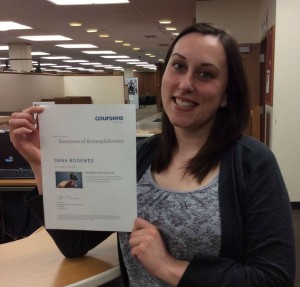My First MOOC: A New Year’s Resolution Revisited
By Dana Bodewes, Instructional Designer
 In January, I enrolled in my first MOOC to learn more about this controversial form of instruction. It was definitely valuable, both for instructional design research and as a learning experience.
In January, I enrolled in my first MOOC to learn more about this controversial form of instruction. It was definitely valuable, both for instructional design research and as a learning experience.
The course was designed around five basic elements: video lectures, readings, weekly online quizzes, discussion boards, and video recorded “office hours”. Each Sunday, the instructor would post readings, lectures, and a quiz for the week. Lectures ranged in duration and number, with four to eight lectures a week each between 10-20 minutes in length. Required “reading” for the week usually consisted of articles, videos (several Ted Talks), and book chapters, all thoughtfully provided for free through the course. Weekly online quizzes contained 20 multiple choices questions, written largely at the lowest level of Bloom’s taxonomy. I spent about six hours each weekend reading and watching videos. Online discussions were student-generated and optional. However, during the first week of the course, a forum was created where students could submit questions for the instructor. At the end of the week, the instructor selected a few questions and posted a video response, calling it “office hours.” I will admit that I did not participate in the optional discussion boards. There were over a hundred pages of discussion thread topics and I found myself disinterested in the random debates of thousands of unknown classmates.
The instructor’s video lectures were thought-provoking topics that held my interest, despite a traditional “sage on the stage” approach. Students watched the instructor lecturing on a Yale production studio stage. Occasionally, images, graphs, or quotes were displayed in a split screen format next to the instructor, but presentation slides were generally not utilized. The professor discussed lots of research, terms, and scientists. The lack of visual supports made it more difficult to process all the lecture details. Without the support of a textbook or slide presentation, I often missed important facts later represented on the quiz. This small frustration reminded me of the importance of using visual cues to assist in the processing of new information, especially when discussing names and terms that are hard to aurally discern.
One of the common complaints about MOOCs is that they provide for little or no interaction with the instructor. This concern is valid. I had no direct communication with my instructor for this course. If I was enrolled in a face-to-face or online course, I would have most certainly asked questions of my professor and discussed topics with my peers. There are fears that MOOCs might replace college courses with an impersonal broadcast of learning. Elements integral to active learning were not present in my MOOC course and I don’t consider MOOCs to yet provide an experience wholly equivalent to a traditional or online course. With thousands of students, it would be difficult for a free online course to sustain the same level of interaction. To provide course credit for MOOCs, rigorous certification standards would surely be necessary.
Although active learning is a powerful form of instruction, I still appreciated the MOOC for what it could offer. I treated the experience as form of self-instruction. The most positive benefit for me was access to a free course thoughtfully arranged by an expert in the field. This expert selected insightful readings and provided poignant lectures, conveniently presented for my learning pleasure. I don’t begrudge the Discovery Channel or the New York Times for failing to design active learning experiences; but then, they are not expected to do so. I appreciated my first MOOC for what it could provide, however unidirectional. The learning experience was filled with rich resources and well worth the investment of my time. I look forward to taking more MOOCs in the future.
Originally published 3/25/2014 in PLU’s Instructional Technologies blog


